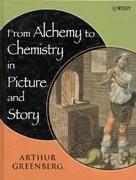John Hudson reviews this book dealing with the history of chemistry
From alchemy to chemistry in picture and story
Arthur Greenberg
New Jersey: Wiley-Interscience 2007 | Pp637 | £36.95 | ISBN0 471 75154 5
Reviewed by John Hudson

Chemistry needs enthusiastic communicators, and this description applies to Arthur Greenberg. His book describes episodes in the long history of chemistry which are interesting, exciting, amusing or just plain odd.
The book is not, and does not claim to be, a comprehensive history of chemistry. The content consists of nearly 200 brief essays, grouped together in 10 chapters, accompanied by 350 in-text illustrations, 24 of which are reproduced as colour plates. Greenberg's stated aim is to 'provide an entertaining, attractive and informative tour through this history for high school and college chemistry teachers and students, practising professionals in science and medicine, as well as the lay public interested in science and appreciative of artwork and illustration'. The text will be accessible to anyone with some chemical knowledge, though I suspect a non-scientist would find some essays heavy going.
As Greenberg says, this is a book to be skimmed as much as read from cover to cover. He gives some of his essays quirky or amusing titles, eg Trade ya Babe Ruth for Antoine Lavoisier! At the risk of sounding stuffy, I find such titles annoying. One of the book's strengths is it deals with several topics which are relatively unfamiliar. Thus we learn about some little known American chemists, as well as two late 16th century attempts to produce a concoction with the properties of Viagra. The illustrations are superb, and in some cases come from little known sources.
I liked this book, but I have a few reservations. It is based on two earlier works by Greenberg - A chemical history tour (2000), and The art of chemistry (2003). Most of the essays (and illustrations) in this volume have appeared before, so an individual or library already possessing the earlier works will not be getting much that is new. Furthermore, the book would have benefited from more thorough editing because occasionally there is some overlap between essays derived from the two parent volumes. Perhaps more serious is that the opportunity has not been taken to eliminate a few errors that crept into the earlier works, so we are still presented with an inaccurate account of the formation of stalactites and stalagmites, and an equation showing copper reacting with dilute sulfuric acid to yield hydrogen.
Minor quibbles aside, Greenberg is to be congratulated on producing a book that will have wide appeal. I cannot imagine any chemist or student or teacher of chemistry not being fascinated by this book, and at £36.95 for 637 densely packed and lavishly illustrated pages in hardback format, it represents excellent value for money.






No comments yet